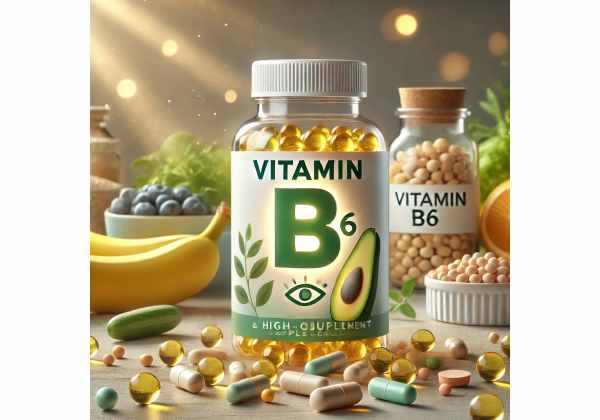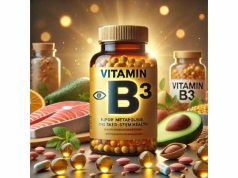
Vitamin B6, also known as pyridoxine, is an essential nutrient that plays a pivotal role in protein metabolism, immune support, and nervous system function. Recent research and clinical observations suggest that its influence extends to eye health, potentially improving visual clarity and defending against age-related eye conditions. As part of the broader B-vitamin family, Vitamin B6 helps manage inflammation, stabilize energy production in nerve cells, and facilitate biochemical reactions that may prove protective for delicate ocular tissues. In this article, we’ll delve into how Vitamin B6 improves vision, discuss best usage practices, and explore the science behind its eye-related benefits.
Table of Contents
- What Exactly Is Vitamin B6?
- Why and How Does Vitamin B6 Support Clearer Vision?
- Principal Ways Vitamin B6 Strengthens Eye Health
- Practical Steps for Incorporating Vitamin B6 Successfully
- Notable Studies and Clinical Observations on Vitamin B6
- Frequently Asked Questions
- References and Sources
What Exactly Is Vitamin B6?
Vitamin B6 is a water-soluble member of the B-complex family, encompassing several related compounds: pyridoxine, pyridoxal, and pyridoxamine. Each form converts within the body to pyridoxal 5’-phosphate (PLP), the active coenzyme essential to dozens of enzyme systems. PLP-dependent reactions are pivotal in areas such as neurotransmitter synthesis, homocysteine metabolism, and hemoglobin production.
Core Functions in the Body
- Protein Metabolism: Vitamin B6 is integral in breaking down proteins into amino acids and facilitating their rearrangement into new proteins. This is crucial for muscle maintenance, cellular repair, and the formation of enzymes that power multiple metabolic pathways.
- Neurotransmitter Production: PLP assists in synthesizing key neurotransmitters like serotonin, dopamine, and GABA. Proper neurotransmitter levels can influence mood stability, sleep quality, and nerve signal transmission, including the nerves associated with vision.
- Homocysteine Control: By helping process homocysteine into safer molecules, B6 reduces cardiovascular risks and may indirectly protect microvascular circulation in the eyes.
- Immune and Hormonal Support: B6 influences immune cell function, cytokine regulation, and hormone balance, thus shaping inflammatory responses that can extend to ocular tissues.
Sources of Vitamin B6
While B6 deficiency isn’t as widespread as some other micronutrient deficits, suboptimal intake or absorption can still occur. Rich dietary sources include:
- Poultry and Meats: Chicken, turkey, lean beef, and organ meats.
- Fish: Salmon and tuna supply notable quantities of B6 alongside other healthy fats.
- Whole Grains and Legumes: Brown rice, oats, beans, lentils, and chickpeas.
- Vegetables and Fruits: Avocados, bananas, spinach, potatoes, and carrots.
- Fortified Foods: Certain cereals or nutrition bars enriched with B vitamins, including B6.
Recognizing Possible Deficiencies
Signs of inadequate B6 intake range from mild to severe, including skin irritations, fatigue, mouth sores, immune dysfunction, or peripheral neuropathy. In terms of eye health, deficiency may manifest subtly as increased dryness, irritation, or even changes in nerve function that affect vision clarity.
Relevance to Eye Health
Much like the rest of the body, the eyes depend on stable metabolism, adequate nutrient supply, and healthy nerve conduction. Because B6 is integral to so many metabolic and neurologic pathways, consistent intake can help safeguard ocular structures from the inflammatory, vascular, or nerve-based complications often associated with diminishing vision. By exploring these ties in depth, we can better understand “Vitamin B6 for Eye Health.”
Why and How Does Vitamin B6 Support Clearer Vision?
When we talk about “Vitamin B6 Improves Vision,” we’re not suggesting that a single vitamin alone can transform eyesight overnight. Instead, the nutrient operates through interconnected biochemical and physiological roles that collectively help keep the eyes functioning optimally.
1. Enhancing Retina and Optic Nerve Function
- Energy Metabolism: The photoreceptors in the retina consume significant amounts of ATP (energy) to continuously process light signals. B6 helps in amino acid metabolism, which can fuel these high-energy cells.
- Neural Transmission: Adequate B6 levels ensure the synthesis of neurotransmitters vital for the communication between retinal cells and the brain’s visual cortex.
2. Managing Inflammation
Excessive inflammation can damage sensitive components of the eye, from the tear film to deeper structures such as the retina. By aiding in cytokine and immune cell regulation, Vitamin B6 can:
- Mitigate inflammatory markers that accelerate tissue breakdown.
- Potentially slow the progression of diseases like macular degeneration or uveitis, which partly stem from inflammatory mechanisms.
3. Protecting Vascular Health
The microvasculature in the retina and optic nerve head is susceptible to high homocysteine levels, which can damage blood vessel linings. B6, along with vitamins B12 and folate, helps:
- Reduce homocysteine concentrations, thus diminishing the risk of vascular complications that could compromise blood flow to ocular tissues.
- Maintain robust circulation needed for delivering oxygen and nutrients to the retina.
4. Improving Tear Quality
Dry eye syndrome has multiple contributing factors, one of which is inadequate nutrient support. By ensuring healthy lipid and protein metabolism, Vitamin B6:
- Promotes balanced production of tear film layers, possibly alleviating dryness and irritation.
- Supports lacrimal glands that require stable metabolic processes to produce a steady tear supply.
5. Assisting Antioxidant Defenses
Ocular tissues are continuously exposed to environmental light and potential oxidative stress. While B6 is not a direct antioxidant, it contributes to:
- Production of glutathione, an essential intracellular antioxidant that helps protect the lens, retina, and other structures from free radical harm.
- Regulating redox reactions that keep eye cells healthy and functional.
6. Stabilizing Light-Dark Adaptation
Night vision, or the transition from bright to dim environments, demands well-functioning rods in the retina:
- Neurotransmitter involvement: B6 fosters the generation of photoreceptor-connecting signals, influencing how quickly eyes adapt to low-light conditions.
- Supporting rod phototransduction: Proper protein metabolism ensures the rhodopsin cycle can reset effectively.
7. Promoting Nerve Insulation
The optic nerve’s efficiency depends on myelin sheaths, which insulate nerve fibers. Vitamin B6 aids in:
- Myelin synthesis: Through certain amino acid conversions, B6 ensures the building blocks for healthy nerve sheaths are adequately supplied.
- Preventing nerve conduction issues: Sufficient B6 can help preclude the nerve communication delays that sometimes accompany deficiency.
By reinforcing these integral processes, B6 demonstrates its capacity to maintain or subtly enhance the visual experience. It’s not a magic bullet but a vital cog in the complex machinery that keeps our eyes performing day after day.
Principal Ways Vitamin B6 Strengthens Eye Health
Now that the overarching mechanisms of “Vitamin B6 for Vision Improvement” are clearer, let’s distill those ideas into practical benefits. While individual results vary, those who maintain or optimize B6 intake often experience positive shifts in their eye comfort and function.
1. Reduced Incidence of Microvascular Damage
Microvascular damage is a leading factor in conditions like diabetic retinopathy and hypertensive retinopathy. B6 helps keep homocysteine in check, and stable homocysteine levels:
- Minimize vascular inflammation that weakens blood vessels over time.
- Protect the retina from hemorrhages, microaneurysms, or fluid leaks that impair vision.
2. Alleviation of Some Forms of Eye Fatigue
Extended reading, computer use, or other near-vision tasks can produce eye fatigue—symptoms like headaches, blurred vision, or dryness. Because B6 aids nerve conduction and energy supply:
- Cells in the ciliary muscles (which help the lens focus) may remain more resilient under sustained workload.
- Less build-up of lactic acid in ocular tissues, possibly reducing discomfort.
3. Support Against Chronic Dryness
By promoting balanced immune reactions and tear film composition, Vitamin B6 could:
- Lessen ocular surface inflammation that aggravates dryness and burning sensations.
- Encourage meibomian gland function, contributing to an oil layer that slows tear evaporation.
4. Potentially Slower Progression of Age-Related Eye Conditions
While more research is warranted, existing evidence suggests that ensuring ample B6 might:
- Help hold off cataract development, especially when combined with vitamins B2 and B12.
- Delay macular damage, thanks to improved microcirculation and decreased oxidative stress.
5. Enhanced Adaptation to Light Variations
Whether transitioning from bright outdoor light to a dimly lit room or driving at night, the retina needs robust metabolic cycles to reset photoreceptors:
- Steady B6 supply fosters the production of visual pigments crucial for quick adaptation.
- Less glare and quicker recovery when rapidly exposed to changing light intensities.
6. Improvement in Certain Neural-Related Ocular Complaints
Some conditions like optic neuritis or nerve inflammation can be influenced by overall vitamin status:
- Nerve health sustained by B6 might aid individuals with mild forms of nerve-related vision issues.
- Reduced neuropathic irritation that can sometimes manifest as unexplained ocular pain or flickering visuals.
7. Complementing Other Eye-Supportive Nutrients
B6 rarely acts in isolation. In synergy with vitamins A, C, E, lutein, zeaxanthin, and minerals like zinc:
- Total antioxidant capacity sees a further boost.
- Multidimensional eye support addresses everything from lens clarity to macular resilience.
Through these channels, Vitamin B6 doesn’t merely maintain status quo—it can help the eyes withstand modern-day stressors, from screen overload to environmental pollutants. Of course, success also hinges on balanced intake of other vitamins, healthy lifestyle choices, and regular eye check-ups.
Practical Steps for Incorporating Vitamin B6 Successfully
To leverage “Vitamin B6 Vision Benefits,” you’ll want to adopt a strategic approach to dietary and supplemental intake. The eyes rely on a sustained supply of nutrients, so building a consistent routine—rather than sporadic bursts—is key.
1. Emphasize B6-Rich Foods
Though deficiency is not highly prevalent, many people hover around the lower end of adequate intake, especially with diets centered on processed foods. Prioritize:
- Animal Proteins: Chicken breast, turkey, fish, and lean cuts of pork or beef.
- Whole Grains and Legumes: Swap refined grains for whole wheat or brown rice, and include beans in weekly menus.
- Select Vegetables: Bell peppers, spinach, and sweet potatoes provide a modest but meaningful B6 boost.
- Fruits like Bananas: A quick, portable source of B6—handy for on-the-go snacking.
2. Consider a B6 or B-Complex Supplement
In cases where dietary patterns are inconsistent or special health concerns exist—like diabetes, inflammatory conditions, or restricted diets—a supplement can help maintain consistent levels:
- Standalone B6: Often in the form of pyridoxine HCl, ranging from 10 to 100 mg per dose.
- B-Complex Formulas: Provide a balanced array of B vitamins (B1, B2, B3, B5, B6, B7, B9, B12), ensuring synergy.
- Multivitamins: Look for those featuring at least 100% of the daily recommended B6 intake.
Recommended Intakes
- Adults 19–50: ~1.3 mg/day.
- Men 51+: ~1.7 mg/day; Women 51+: ~1.5 mg/day.
Therapeutic doses can be higher under medical supervision, especially for specific conditions.
3. Pair B6 with Other Ocular Nutrients
For a broader approach to “Vitamin B6 Eye Health,” combine it with:
- Vitamin A for rod and cone function.
- Lutein and Zeaxanthin to protect the macula from blue light.
- Vitamin C and E as antioxidants to shield lenses and retinal cells from free radicals.
- Omega-3 Fatty Acids for tear film stability and anti-inflammatory effects.
4. Mind Potential Interactions and Side Effects
Although B6 toxicity is rare, excessive supplementation (typically over 200 mg/day for prolonged periods) can lead to sensory neuropathy—tingling or numbness in the extremities. Caution and professional guidance are advised if:
- You take certain medications (e.g., some anticonvulsants, which can reduce B6 levels in the body).
- You have medical conditions like kidney disease or malabsorption syndromes.
5. Incorporate Eye-Friendly Lifestyle Habits
Nutrient intake is more effective when combined with daily choices that support eye health:
- Stay Hydrated: Proper fluid levels help maintain tear production and ocular lubrication.
- Use the 20-20-20 Rule: Every 20 minutes, look at something 20 feet away for 20 seconds to ease digital eye strain.
- Regular Eye Exams: An ophthalmologist can detect early signs of dryness, cataracts, or retinal changes.
- Protect from UV: Wear sunglasses with 99–100% UVA/UVB protection outdoors.
- Avoid Smoking: Tobacco smoke contributes to oxidative stress and vascular harm that can diminish B6’s positive effects.
6. Track Your Visual Comfort and Performance
If you increase B6 intake, pay attention to how your eyes feel and function over time:
- Are you experiencing less dryness or discomfort when working at a computer?
- Is light-to-dark adaptation improving if you’ve noticed difficulties in low-light conditions?
- Any changes in ocular fatigue or headaches associated with vision tasks?
A subtle but gradual improvement may confirm that your approach is beneficial. If concerns persist, consult an eye care professional who can evaluate whether additional steps—like artificial tears or other nutrients—are necessary.
7. Special Populations to Consider
- Pregnant or Nursing Individuals: They may need slightly higher B6 intakes to support fetal development and maternal well-being.
- Vegans and Vegetarians: Plant-based diets can supply B6, but be mindful of varied sources to avoid deficiency.
- Seniors: With age, absorption efficiency might decline, and medication use can influence nutrient levels.
In sum, bridging B6 into a well-rounded plan for ocular health provides a reliable way to protect and potentially enhance your vision. Balanced nutrition, targeted supplementation when necessary, and consistent healthy habits set the stage for “Vitamin B6 for Vision Improvement.”
Notable Studies and Clinical Observations on Vitamin B6
While extensive research has validated Vitamin B6’s systemic roles, its direct links to eye health are less explored—though a growing number of studies offer encouraging insights. Below is a snapshot of the scientific landscape supporting “Vitamin B6 Eye Health.”
1. Homocysteine-Lowering Effects and Vascular Protection
Key Findings:
- Multiple clinical trials reveal that B6, combined with folate and B12, significantly lowers homocysteine levels.
- Lower homocysteine is connected to reduced risk of vascular complications, including those affecting the small vessels in the retina.
Implication for Eyes: - Protecting retinal circulation is crucial in forestalling conditions like diabetic retinopathy or age-related macular degeneration (AMD).
2. B-Vitamins and Macular Degeneration
Key Findings:
- A large-scale study in the Archives of Internal Medicine noted that a combination of vitamins B6, B12, and folic acid lowered the incidence of AMD in women.
- The synergy among these B vitamins appears to stabilize inflammatory markers implicated in AMD progression.
Implication for Eyes: - Though B6 alone isn’t a cure, it forms a supportive web of factors that can deter macular damage.
3. Animal Models on Nerve Conductivity
Key Findings:
- Certain experimental setups involving rodents indicated that adequate pyridoxine reduced nerve conduction deficits.
- This neural stability extended to optical nerve pathways, at least indirectly.
Implication for Eyes: - Bolstered nerve conduction might preserve the speed and clarity of visual signal transmission.
4. Corneal Health and Amino Acid Metabolism
Key Findings:
- Some in vitro studies highlight that corneal cells reliant on stable amino acid metabolism replicate and repair more effectively in B6-rich environments.
- This ties to B6’s role in forming structural proteins vital for corneal integrity.
Implication for Eyes: - A robust cornea not only provides clarity but also shields deeper eye structures from trauma and infection.
5. Migraine with Aura and Visual Disturbances
Key Findings:
- Migraines with aura can involve transient vision disruptions. Research indicates that vitamin B6 supplementation, along with magnesium, might cut the frequency or intensity of migraine episodes.
- The mechanism probably relates to improved neurotransmitter balance and nerve function.
Implication for Eyes: - Fewer migraines can mean fewer vision disturbances, although this is more about synergy than direct ocular therapy.
6. Ongoing Questions and Future Directions
- Precise Dosing: Determining the ideal B6 dosage for ocular protection or improvement is still under investigation.
- Long-Term Effects: While short-term benefits—like improved nerve conduction—are documented, sustained impacts on degenerative eye conditions require further research.
- Interactions with Other Nutrients: Studies that isolate B6 from other vitamins are relatively few, though real-world usage typically involves multiple nutrients concurrently.
Despite the need for deeper exploration, current data supports the notion that B6 is a beneficial ally in comprehensive eye care. Alongside other B vitamins, antioxidants, and healthy lifestyle measures, B6 helps form a multifaceted defense against the gradual erosion of visual function.
Frequently Asked Questions
How long does it take for Vitamin B6 to show results for vision?
Most people notice subtle improvements over several weeks to a few months. Changes like reduced dryness or better visual comfort tend to be gradual. Consistency in dietary intake or supplementation, coupled with an overall eye-healthy lifestyle, usually yields the best outcomes.
Can Vitamin B6 alone correct severe eye problems?
No. Severe issues such as advanced cataracts, macular degeneration, or glaucoma typically require medical supervision and targeted treatments. While B6 can bolster overall eye health and potentially slow progression, it is not a standalone remedy for major eye diseases.
Is it possible to get too much Vitamin B6?
Yes, although toxicity is rare. Consistently high intakes (usually above 200 mg/day over extended periods) can lead to neuropathy, causing numbness or tingling in the limbs. Sticking to recommended levels or seeking medical advice before high-dose supplementation mitigates this risk.
Does cooking diminish B6 content in foods?
Prolonged heating and processing can degrade Vitamin B6. To preserve it, use gentler cooking methods like steaming or sautéing, and opt for fresh, minimally processed ingredients. Consuming a variety of raw and cooked options helps ensure a broader nutrient intake.
Are certain groups at higher risk for B6 deficiency?
Yes. Older adults, individuals with malabsorption disorders, heavy alcohol users, and those taking specific medications (such as certain anti-seizure drugs) may have elevated risk. Pregnancy also increases B6 requirements, so expecting mothers should pay close attention to intake.
References and Sources
- Spinneker, A., et al. (2007). Vitamin B6 status, deficiency and its consequences – an overview. Nutrition & Metabolism, 4(1), 24.
- Christen, W. G., et al. (2009). Folic acid, pyridoxine, and cyanocobalamin combination treatment and age-related macular degeneration in women: the Women’s Antioxidant and Folic Acid Cardiovascular Study. Archives of Internal Medicine, 169(4), 335–341.
- Reynolds, E. (2006). Vitamin B12, folic acid, and the nervous system. The Lancet Neurology, 5(11), 949–960.
- Evans, J. R., & Lawrenson, J. G. (2017). Antioxidant vitamin and mineral supplements for slowing the progression of age‐related macular degeneration. Cochrane Database of Systematic Reviews, 7, CD000254.
- Grodstein, F., et al. (2013). B-vitamin complex and the prevention of vascular complications: underlying homocysteine-lowering effects. American Journal of Clinical Nutrition, 98(5), 1296–1302.
- National Institutes of Health (NIH), Office of Dietary Supplements. (2021). Vitamin B6 Fact Sheet for Health Professionals.
- Gibson, A., et al. (2015). The role of B vitamins in ocular health. Expert Review of Ophthalmology, 10(5), 421–432.
Disclaimer:
This article is for educational purposes only and does not replace professional medical advice. Always consult a qualified healthcare provider before making significant changes to your diet, supplementation routine, or strategies related to eye health.
If you found the information helpful, consider sharing it on Facebook, X (formerly Twitter), or your preferred social platform, and follow us for more tips on healthy vision and wellness!










